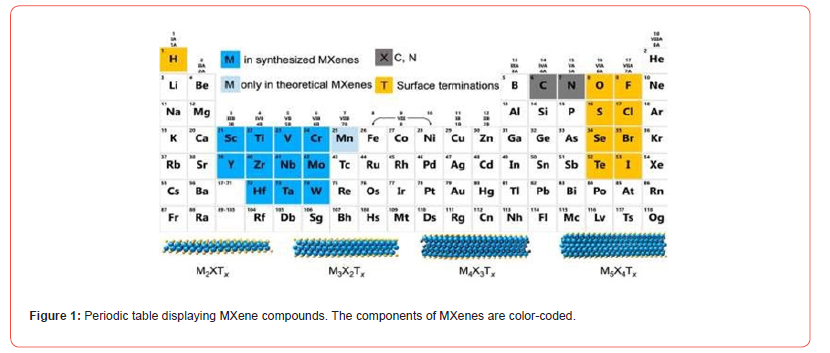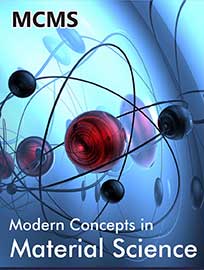 Review Article
Review Article
MXenes at the Crossroads: Unlocking the Next Generation of 2D Materials
Qasimullah1*, Aiddah Naz2, Irfan Ullah2 and Urooj Tariq3
1Department of Physical and Numerical Sciences. Qurtuba University of Science and Information Technology, Peshawar 25100, Pakistan
2Department of Physics Abdul Wali Khan University Mardan 23200, KP, Pakistan
3Department of Mathematics, COMSATS University Islamabad, Abbottabad Campus, 22060, Pakistan
Qasimullah, Department of Physical and Numerical Sciences. Qurtuba University of Science and Information Technology, Peshawar 25100, Pakistan.
Received Date:June 19, 2025; Published Date:July 07, 2025
Abstract
MXenes, a family of two-dimensional transition metal carbides, nitrides, and carbonitrides, have garnered significant attention due to their remarkable properties and potential applications. This review highlights the structure, electronic properties, and surface terminations of MXenes, as well as their potential uses in energy storage, electrocatalysis, and other fields. Theoretical calculations using density functional theory (DFT) are also discussed, providing insights into the physicochemical properties and modification mechanisms of MXenes. The review aims to summarize the current state of MXene research and explore their future prospects in various applications.
Introduction & Literature Review
The discovery of graphene’s brought the attention of researchers to the remarkable qualities of two-dimensional materials. Since then, interest in graphene’s close relatives and other 2D layered nanomaterials has grown due to graphene’s lack of an intrinsic band gap and limited amenability to chemical modification [1]. MXenes are a family of two-dimensional transition metal carbides, nitrides, and carbonitrides with a general formula of Mn+1XnTx. In these compounds, layers of C and N (represented as X) are interleaved layers of transition metal (M: Ti, Nb, V, Cr, Mo, Ta, etc.), and Tx stands for surface termination groups like −OH, −O, and –F [2]. The presence of F, O, and OH functional groups can modify MXenes physicochemical characteristics, particularly conductivity [3]. Some examples of MXene include Ti2CTx, Ti3C2Tx and Nb4C3Tx [4].
MXenes provide an opportunity to synthesize a wide range of novel structures. Because of their adaptable chemistry, MXenes can have their properties tailored for a variety of uses, such as lubrication, photocatalysis, electrocatalysis and chemicalcatalysis, energy storage, composite reinforcement, shielding against electromagnetic interference, water purification, gas and biosensors. Additionally, they demonstrated appealing optical, plasmonic, thermoelectric, and electrical properties [5].
Reversible chemical/electrochemical intercalation, applied voltage, or illumination can be used to further control MXenes properties [6]. By considering multiple metals M and non-metals X, it is feasible to create an unlimited number of compositions. MXenes with more than one M element also exist in two forms: solid solutions and ordered phases. In the former, a random arrangement of two different transition metals is observed in the M layers. In contrast, in the ordered MXenes, single or double layers of one transition metal (for example, Ti) are sandwiched between the layers of a second transition metal (for example, Mo) in a 2D carbide structure. For certain combinations of transition metals, ordered MXenes are energetically more stable than their solidsolution counterparts [7].

MXenes are promising as electrodes for batteries and supercapacitors because of their metallic electronic conductivity, reversible redox reactions of the surface transition metal layers, and spontaneous intercalation of cations, including multivalent ions [8,9]. MXenes with low formula weights, such as Ti2C, Nb2C, V2C and Sc2C, are the most promising for energy storage applications. In particular, M2X electrodes are expected to show higher gravimetric capacities for Li storage than their M3X2 and M3X4 counterparts, because the latter have inactive internal M and X layers. For example, the gravimetric capacity of Ti2CTx for Li+ uptake was found to be ~1.5 times higher than that of Ti3C2Tx prepared in the same way. V2CTx shows the highest Li+ capacity of all MXenes tested under similar conditions [4]. MXene offers a wide range of uses in electrocatalysis and energy storage, but relatively few MXene materials have been experimentally produced and there is still a dearth of information on metal doping and modification mechanisms of MXenes. The experiments also require a lot of time, effort, and the use of harsh chemicals. To complement and guide experiments, theoretical calculations have been successfully used to analyze the physicochemical properties, adsorption behavior, and modification mechanisms of MXenes [10].
Structure and electronic properties in these systems can be accurately described by quantum mechanical methods, such as density functional theory (DFT). DFT has emerged as a powerful theoretical tool to study the chemical and physical properties of materials throughout the past century. Over the past 20 years, it has been a commonly used instrument in the majority of chemical and material science domains. DFT has gained popularity because of its accuracy and low computing cost [11]. Various exchange correlation functionals are used to study the electronic properties of materials [12]. Hybrid functionals combining DFT with Hartree- Fock (HF) exchange, or exact exchange, are an efficient way to achieve an accurate description of electronic properties, such as band gaps and optical absorption [13]. Hybrid DFT has been used to study MXenes, as it has been shown to describe the electronic structure of MXenes more accurately than standard DFT methods [14]. The electronic properties, hydrophilicity, and ion interaction of MXenes are greatly influenced by surface terminations such as -OH, -O and -F. Past research has indicated that these terminations can have an impact on MXenes’ conductivity, work function, and lithium ions intercalation [15]. Transition metal doping of MXenes can modify their electrical structure, improve stability, and customize their properties for particular uses. For example, it has been demonstrated that metal doping focusing on conductivity and Lithium intercalation [16]. MXenes have the potential to be combined with other 2D materials, such as graphene, to generate hybrid structures with synergistic features for applications in electronics, sensors, and energy storage devices [17].
Conclusion
MXenes have shown great promise in various applications due to their unique properties. Further research is needed to explore their potential and overcome challenges associated with their synthesis and modification. This review aims to provide a comprehensive overview of MXene research, highlighting their potential and future directions.
References
- Koski K J, Cui Y (2013) The new skinny in two-dimensional nanomaterials. ACS nano 7(5): 3739-3743.
- Deysher G, Shuck C E, Hantanasirisakul K, Frey N C, Foucher A C, et al. (2019) Synthesis of Mo4VAlC4 MAX phase and twodimensional Mo4VC4 MXene with five atomic layers of transition metals. ACS nano 14(1): 204-217.
- Abdelmalak M N (2014) MXenes: A new family of two-dimensional materials and its application as electrodes for Li-ion batteries. Drexel University.
- Anasori B, Lukatskaya M R, Gogotsi Y (2017) 2D metal carbides and nitrides (MXenes) for energy storage. Nature Reviews Materials 2(2): 1-17.
- Anasori B, Lukatskaya M R, Gogotsi Y (2017) 2D metal carbides and nitrides (MXenes) for energy storage. Nature Reviews Materials, 2(2): 1-17.
- Vahid Mohammadi A, Rosen J, Gogotsi Y (2021) The world of twodimensional carbides and nitrides (MXenes). Science 372(6547): eabf1581.
- Anasori B, Yu Xie, Majid Beidaghi, Jun Lu, Brian C Hosler, et al. (2015) Two-Dimensional, Ordered, Double Transition Metals Carbides (MXenes). ACS Nano 9(10): 9507-9516.
- Driscoll N, Richardson A G, Maleski K, Anasori B, Adewole O, et al. (2018) Two-dimensional Ti3C2 MXene for high-resolution neural interfaces. Acs Nano 12(10): 10419-10429.
- Salles P, Pinto D, Hantanasirisakul K, Maleski K, Shuck C E, et al. (2019) Electrochromic effect in titanium carbide MXene thin films produced by dip‐coating. Advanced Functional Materials 29(17): 1809223.
- Zhu H, Liang Z, Xue S, Ren X, Liang X, et al. (2022) DFT practice in MXene-based materials for electrocatalysis and energy storage: From basics to applications. Ceramics International 48(19): 27217-27239.
- Burke K (2012) Perspective on density functional theory. The Journal of chemical physics 136(15): 150901
- Hohenberg P, Kohn W (1964) Inhomogeneous electron gas. Physical review 136(3B): B864.
- Perdew J P, Ernzerhof M, Burke K (1996) Rationale for mixing exact exchange with density functional approximations. The Journal of chemical physics 105(22): 9982-9985.
- Gouveia J D, Gomes J R (2024) Structural and electronic properties of the titanium carbide MXene with variable sublattice oxygen composition. Surfaces and Interfaces 46: 103920.
- Tang M, Li J, Wang Y, Han W, Xu S, et al. (2022) Surface terminations of MXene: synthesis, characterization, and properties. Symmetry 14(11): 2232.
- Anand R, Ram B, Umer M, Zafari M, Umer S, et al. (2022) Doped MXene combinations as highly efficient bifunctional and multifunctional catalysts for water splitting and metal–air batteries. Journal of Materials Chemistry A 10(42): 22500-22511.
- Yang X, Wang Q, Zhu K, Ye K, Wang G, et al. (2021) 3D porous oxidation‐resistant mxene/graphene architectures induced by in situ zinc template toward high‐performance supercapacitors. Advanced Functional Materials 31(20): 2101087.
-
Qasimullah*, Aiddah Naz, Irfan Ullah and Urooj Tariq. MXenes at the Crossroads: Unlocking the Next Generation of 2D Materials. Mod Concept Material Sci. 7(2): 2025. MCMS. MS.ID.000659.
-
Electronic properties, Density, Electrocatalysis, Energy storage, Nanomaterials, Plasmonic, Applied voltage, Quantum, Functional theory
-

This work is licensed under a Creative Commons Attribution-NonCommercial 4.0 International License.






